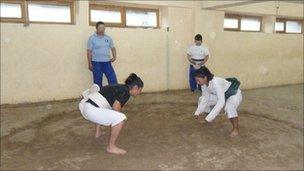Mongolian women wrestling for sumo success
- Published

Women can compete only in amateur sumo events
Sumo wrestling has taken Mongolia by storm. Its male wrestlers have reached the peak of the sport in Japan, from where it originates, and in recent years, more and more women have been entering the ring.
In a half-lit room in the basement of a building in central Ulan Bator, the location of the Sumo Federation of Mongolia, coach Sogoo Yadamdorj and her team of female wrestlers are preparing for their first training session of the day.
The girls quickly change into training outfits and begin warming up while the coach waters the sand-covered training ground in the middle of the room.
The national team has a dozen competitors, the oldest is 30, the youngest is just 15.
"My team is getting younger as the sport becomes more popular in Mongolia," says coach Sogoo.
"In 2002, when Mongolia began taking part in world female sumo championships, I had to beg for people from the judo team. Now, girls as young as 10 years old come to train with us."
There are no official statistics, but according to the coach, thousands of girls practise sumo across the country.
The Mongolian female team has been competing successfully across the world and almost never comes back from international tournaments empty-handed.
"Mongolia is among the top three teams together with Russia and Ukraine - even the Japanese team is behind us," coach Sogoo says proudly.
"To become a good sumo wrestler you need great balance and the ability to react fast.
"Being a nomad nation, we Mongolians are born with these attributes," she says.
Foreign participants were only allowed to compete professionally in Japan not long ago, but Mongolian sumo wrestlers are now among the very few foreigners who have reached the highest rank of the sumo hierarchy, yokozuna.
And although women can only participate in amateur events - as sumo is still very much considered a male-only sport - coach Sogoo hopes this does not deter girls from practising it.
"Sumo is a great sport," she says. "Apart from being fantastic exercise, it teaches you discipline to maintain stamina and weight."
Hungry for success
Female sumo wrestlers have to follow a strict regime and diet to keep their fighting weight.
The oldest member of Mongolia's national team is 30, the youngest is just 15
There are four weight categories: under 65kg (10 stone), under 80kg (12 stone 7lb), above 80kg and open weight. Heavier weights are considered more desirable.
Thirty-year-old Sunjidmaa Khishidorj weighs 110kg (17 stone 5lb) and is 1.74m (5ft 9in) tall.
Three times the national champion, she is one of the veterans of Mongolian female sumo and one of the most decorated wrestlers in the country.
Sunjidmaa eats three meals a day, including a large lunch and dinner.
"Luckily Mongolian traditional dishes are rich in starch and protein, so I can eat with the family and don't need special food. Only I eat a little more than my husband and son. Well, actually a lot more!" she laughs.
"They don't mind though. My son absolutely loves the fact that his mum is a sumo wrestler."
Despite the weight, Sunjidmaa moves with an admirable speed and grace. She says sumo gives her a good physique and a calm mind.
For Solongo Jargalsaikhan, 15, and a budding champion, there is another reason to do sumo - the hunger for success.
"I was fascinated with the achievements of our countrymen and wanted to join the game."
This month Solongo is taking part in the World Female Sumo Championship in Poland in the under 65kg division.
At 60kg with a 1.6m frame, Solongo admits she is a little too skinny.
"I can only try to eat more, train more and we will see," she says. "This is my first world championship and what I really, really want is to win."
Solongo trains at least twice a day, and with her school work she has little time for anything else.
As for boys' attention, "I don't care about them!" she says.